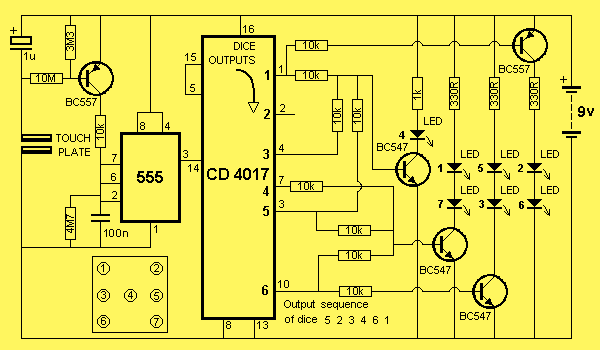
Fridge Door Alarm Schematic 2nd Version

The primary objective of this design was to address a minor flaw in the widely used Fridge Door Alarm circuit, which has been available on this website since 1999 and has been constructed by numerous hobbyists. This circuit ceases to function when the battery voltage drops below approximately 2.6 to 2.7 volts due to the use of the 4060 CMOS IC. In some instances, devices produced by certain manufacturers (excluding Motorola) may fail to operate even at the nominal 3V supply voltage. A straightforward solution to this limitation could involve replacing the original IC with a 74HC4060 chip, which would enable circuit operation down to 2V; however, this IC is not easily obtainable. Consequently, an alternative circuit with a similar component count was developed to ensure reliable operation even when the battery voltage decreases to about 1.3V. The circuit, housed in a compact enclosure, should be positioned in the refrigerator near the lamp (if present) or close to the door opening. When the door is closed, the interior of the refrigerator is dark, causing the photoresistor R2 to exhibit high resistance (>200K), which keeps IC1 clamped by maintaining C1 fully charged through R1 and D1. When light enters the fridge through the opening or the lamp turns on, the photoresistor reduces its resistance (<2K), interrupting the charging current to C1. As a result, IC1, configured as an astable multivibrator, begins oscillating at a low frequency, and after approximately 24 seconds, its output pin (#3) goes high, activating IC2. This chip is also configured as an astable multivibrator, driving the piezo sounder intermittently at a rate of about five times per second. The alarm is triggered for about 17 seconds, followed by a pause of the same duration, with this cycle continuing until the refrigerator door is closed.
The circuit design utilizes a combination of a photoresistor and a CMOS integrated circuit to create a low-power alarm system that functions effectively within the constraints of battery-operated devices. The use of the photoresistor allows for light detection, which is essential for triggering the alarm when the refrigerator door is opened. The astable multivibrator configuration of IC1 ensures that the circuit can generate a consistent oscillation, which is crucial for the timing of the alarm signal.
The choice of components is critical for ensuring the reliability of the circuit at lower voltages. The replacement of the original 4060 CMOS IC with an alternative design allows for continued operation at reduced battery levels, addressing the issue of premature circuit failure. The compact design of the enclosure allows for easy installation within the refrigerator, ensuring that the alarm system is unobtrusive yet effective.
The output from IC1, once activated, drives IC2, which in turn controls the piezo sounder. This component is responsible for generating the audible alarm signal, providing a clear indication when the refrigerator door is left open. The intermittent nature of the alarm, with a 17-second on and off cycle, helps to conserve battery life while still providing a noticeable alert to the user.
Overall, this circuit design presents a robust solution to the limitations of previous fridge door alarm systems, ensuring functionality even under lower voltage conditions while maintaining ease of use and installation.The main purpose of this design was to obviate a small defect of the very popular Fridge Door Alarm circuit, available on this website since 1999 and built by a lot of hobbyists. Unfortunately, that circuit stops operating when the battery voltage falls below about 2. 6 2. 7 Volts. This is due to the 4060 CMos IC used. In some cases, devices mad e by some manufacturers (but not Motorola`s) fail to operate even at nominal 3V supply voltage. A simple cure to this shortcoming could be the substitution of the original IC specified with a 74HC4060 chip: this should allow circuit operation down to 2V but, unfortunately, this IC is not easy to locate. For this reason, an equivalent circuit using about the same parts counting was developed, in order to allow safe operation even when battery voltage falls down to about 1.
3V. The circuit, enclosed in a small box, should be placed in the fridge near the lamp (if any) or close to the opening. With the door closed, the interior of the fridge is in dark, the photo resistor R2 presents a high resistance (>200K) thus clamping IC1 by holding C1 fully charged across R1 and D1.
When a beam of light enters from the opening, or the fridge lamp lights, the photo resistor lowers its resistance (<2K) stopping C1 charging current. Therefore IC1, wired as an astable multivibrator, starts oscillating at a very low frequency and after a period of about 24 sec.
its output pin (#3) goes high, enabling IC2. This chip is also wired as an astable multivibrator, driving the Piezo sounder intermittently at about 5 times per second. The alarm is activated for about 17 sec. then stopped for the same time period and the cycle repeats until the fridge door closes. 🔗 External reference
The circuit design utilizes a combination of a photoresistor and a CMOS integrated circuit to create a low-power alarm system that functions effectively within the constraints of battery-operated devices. The use of the photoresistor allows for light detection, which is essential for triggering the alarm when the refrigerator door is opened. The astable multivibrator configuration of IC1 ensures that the circuit can generate a consistent oscillation, which is crucial for the timing of the alarm signal.
The choice of components is critical for ensuring the reliability of the circuit at lower voltages. The replacement of the original 4060 CMOS IC with an alternative design allows for continued operation at reduced battery levels, addressing the issue of premature circuit failure. The compact design of the enclosure allows for easy installation within the refrigerator, ensuring that the alarm system is unobtrusive yet effective.
The output from IC1, once activated, drives IC2, which in turn controls the piezo sounder. This component is responsible for generating the audible alarm signal, providing a clear indication when the refrigerator door is left open. The intermittent nature of the alarm, with a 17-second on and off cycle, helps to conserve battery life while still providing a noticeable alert to the user.
Overall, this circuit design presents a robust solution to the limitations of previous fridge door alarm systems, ensuring functionality even under lower voltage conditions while maintaining ease of use and installation.The main purpose of this design was to obviate a small defect of the very popular Fridge Door Alarm circuit, available on this website since 1999 and built by a lot of hobbyists. Unfortunately, that circuit stops operating when the battery voltage falls below about 2. 6 2. 7 Volts. This is due to the 4060 CMos IC used. In some cases, devices mad e by some manufacturers (but not Motorola`s) fail to operate even at nominal 3V supply voltage. A simple cure to this shortcoming could be the substitution of the original IC specified with a 74HC4060 chip: this should allow circuit operation down to 2V but, unfortunately, this IC is not easy to locate. For this reason, an equivalent circuit using about the same parts counting was developed, in order to allow safe operation even when battery voltage falls down to about 1.
3V. The circuit, enclosed in a small box, should be placed in the fridge near the lamp (if any) or close to the opening. With the door closed, the interior of the fridge is in dark, the photo resistor R2 presents a high resistance (>200K) thus clamping IC1 by holding C1 fully charged across R1 and D1.
When a beam of light enters from the opening, or the fridge lamp lights, the photo resistor lowers its resistance (<2K) stopping C1 charging current. Therefore IC1, wired as an astable multivibrator, starts oscillating at a very low frequency and after a period of about 24 sec.
its output pin (#3) goes high, enabling IC2. This chip is also wired as an astable multivibrator, driving the Piezo sounder intermittently at about 5 times per second. The alarm is activated for about 17 sec. then stopped for the same time period and the cycle repeats until the fridge door closes. 🔗 External reference





